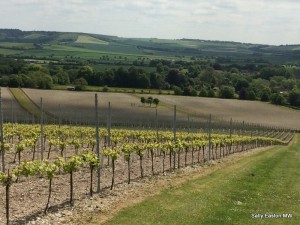May frost and June rain still scourge UK wine grape yields, despite warmer temperatures
New research from the University of East Anglia (UEA) into the impact of climate change on winegrowing in the UK suggest viticulturally extreme weather events, such as cold snaps and downpours, are likely to continue to threaten yields in the newly-nascent, modernised and expanding wine production industry in the UK, despite improving average growing season temperatures.
Lead researcher Alistair Nesbitt, from UEA’s School of Environmental Sciences, said: “The UK has been warming faster than the global average since 1960 and eight of the warmest years in the last century have occurred since 2002.” He and fellow researchers studied temperature, rainfall, extreme weather events and yields in the UK’s main viticultural regions. Since 1993, growing season temperature (GST) has consistently been above 13°C, the lower threshold for cool climate viticulture. Some cultivars will typically ripen successfully at this level, within certain style parameters.
Sparkling wine is often produced in true cool climates. And the UK has seen a dramatic shift to sparkling wine as part of the expansion. Vineyard plantings in the UK increased by nearly 150% in the decade to 2013, with around 1880 hectares now planted. Chardonnay and pinot noir are now the most-planted cultivars.
Despite the UK being above this GST lower threshold, grape yield has continued to vary significantly between 2004 and 2013 (between 6 and 34 hl/ha, levels which are very low by international standards). The research found that while GST can be a useful tool to describe viticultural suitability, precipitation and short term temperature events, such as spring frosts, at critical points in the growing season are a more powerful indicator of yield. Nesbitt said “Over the last 50 years, there has been a positive trend in GST [but] only when you look underneath the average, do you see what’s affecting growth. Within this, rain and spring frosts haven’t really changed, but yields are still widely variable, so these threats remain the same regardless of the temperature [GST].”
These within-season weather effects most concern growers. The researchers found April/May temperatures have increased … this would typically be good for viticulture as budburst occurs at this time (in the northern hemisphere). But they found a warmer April followed by a frosty May increases vines’ vulnerability to damage of the fragile new shoots.
It has also got a bit rainier. They found a 16% increase in growing season precipitation, to 420mm. Importantly, they found June precipitation – critical flowering and fruitset time – has seen no significant change over time. But that June precipitation is the most important weather variable for yield. For example, June 2012 was the wettest June since 1910, with a corresponding lowest yield on record of 6 hL/ha. Indeed 1997 and 2007, as well as 2012, were low yielding, and June precipitation was in the top six of the last 100 years. GST in 1997 and 2007 were both just below 14°, while in 2012 was just short of 13.5°.




